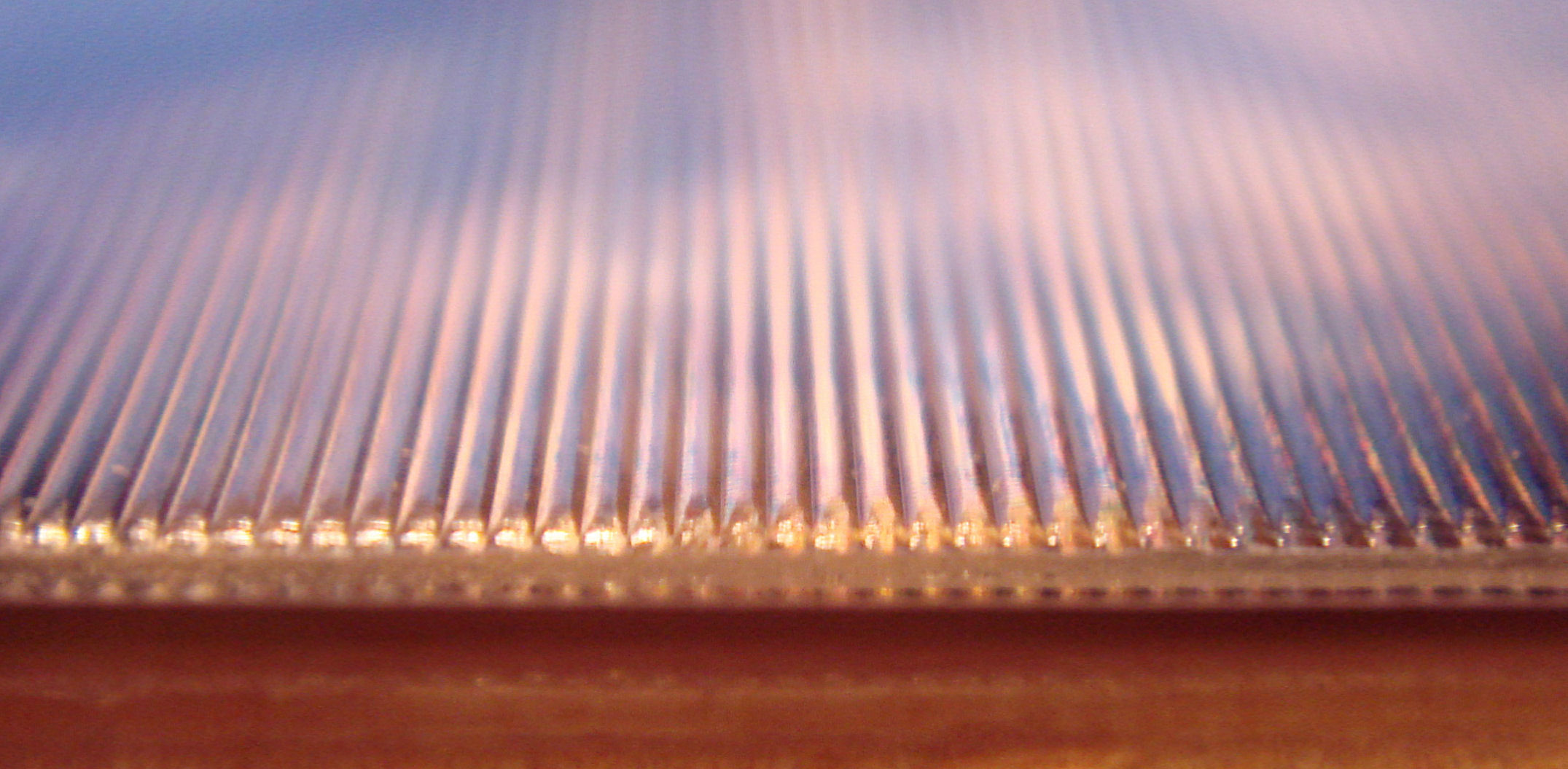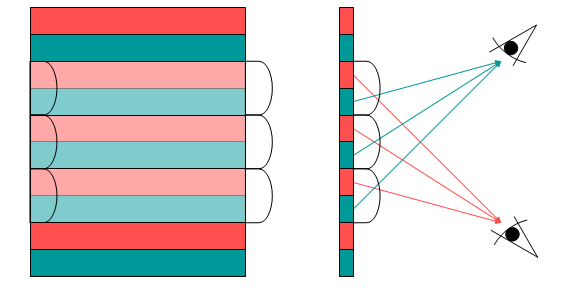|
Integral Photography
Integral imaging is a three-dimensional imaging technique that captures and reproduces a light field by using a two-dimensional array of microlenses (or lenslets), sometimes called a fly's-eye lens, normally without the aid of a larger overall objective or viewing lens. In capture mode, in which a film or detector is coupled to the microlens array, each microlens allows an image of the subject as seen from the viewpoint of that lens's location to be acquired. In reproduction mode, in which an object or source array is coupled to the microlens array, each microlens allows each observing eye to see only the area of the associated micro-image containing the portion of the subject that would have been visible through that space from that eye's location. The optical geometry can perhaps be visualized more easily by substituting pinholes for the microlenses, as has actually been done for some demonstrations and special applications. A display using integral imaging is a type of light field ... [...More Info...] [...Related Items...] OR: [Wikipedia] [Google] [Baidu] |
Light Field
The light field is a vector function that describes the amount of light flowing in every direction through every point in space. The space of all possible '' light rays'' is given by the five-dimensional plenoptic function, and the magnitude of each ray is given by its radiance. Michael Faraday was the first to propose that light should be interpreted as a field, much like the magnetic fields on which he had been working. The phrase ''light field'' was coined by Andrey Gershun in a classic 1936 paper on the radiometric properties of light in three-dimensional space. Modern approaches to light field display explore co-designs of optical elements and compressive computation to achieve higher resolutions, increased contrast, wider fields of view, and other benefits. The term “radiance field” may also be used to refer to similar concepts. The term is used in modern research such as neural radiance fields. The plenoptic function For geometric optics—i.e., to incoherent ligh ... [...More Info...] [...Related Items...] OR: [Wikipedia] [Google] [Baidu] |
Gabriel Lippmann
Jonas Ferdinand Gabriel Lippmann (16 August 1845 – 13 July 1921) was a Franco-Luxembourgish physicist and inventor, and Nobel laureate in physics for his method of reproducing colours photographically based on the phenomenon of interference. His parents were French Jews. Early life and education Gabriel Lippmann was born in Bonnevoie, Luxembourg (Luxembourgish: Bouneweg), on 16 August 1845. At the time, Bonnevoie was part of the commune of Hollerich (Luxembourgish: Hollerech) which is often given as his place of birth. (Both places, Bonnevoie and Hollerich, are now districts of Luxembourg City.) His father, Isaïe, a French Jew born in Ennery near Metz, managed the family glove-making business at the former convent in Bonnevoie. In 1848, the family moved to Paris where Lippmann was initially tutored by his mother, Miriam Rose (Lévy), before attending the Lycée Napoléon (now Lycée Henri-IV). He was said to have been a rather inattentive but thoughtful pupil with a special ... [...More Info...] [...Related Items...] OR: [Wikipedia] [Google] [Baidu] |
Stereoscopy
Stereoscopy (also called stereoscopics, or stereo imaging) is a technique for creating or enhancing the illusion of depth in an image by means of stereopsis for binocular vision. The word ''stereoscopy'' derives . Any stereoscopic image is called a stereogram. Originally, stereogram referred to a pair of stereo images which could be viewed using a stereoscope. Most stereoscopic methods present a pair of two-dimensional images to the viewer. The left image is presented to the left eye and the right image is presented to the right eye. When viewed, the human brain perceives the images as a single 3D view, giving the viewer the perception of 3D depth. However, the 3D effect lacks proper focal depth, which gives rise to the Vergence-Accommodation Conflict. Stereoscopy is distinguished from other types of 3D displays that display an image in three full dimensions, allowing the observer to increase information about the 3-dimensional objects being displayed by head and eye mov ... [...More Info...] [...Related Items...] OR: [Wikipedia] [Google] [Baidu] |
3D Display
A 3D display is a display device capable of conveying depth perception, depth to the viewer. Many 3D displays are stereoscopic displays, which produce a basic 3D effect by means of stereopsis, but can cause eye strain and visual fatigue. Newer 3D displays such as holographic display, holographic and light field displays produce a more realistic 3D effect by combining stereopsis and accurate focal length for the displayed content. Newer 3D displays in this manner cause less visual fatigue than classical stereoscopic displays. As of 2021, the most common type of 3D display is a stereoscopy, stereoscopic display, which is the type of display used in almost all virtual reality equipment. 3D displays can be near-eye displays like in VR headsets, or they can be in a device further away from the eyes like a 3D-enabled mobile device or 3D film, 3D movie theater. The term “3D display” can also be used to refer to a volumetric display which may generate content that can be viewed fro ... [...More Info...] [...Related Items...] OR: [Wikipedia] [Google] [Baidu] |
Plenoptic Camera
A light field camera, also known as a plenoptic camera, is a camera that captures information about the ''light field'' emanating from a scene; that is, the intensity of light in a scene, and also the precise direction that the light rays are traveling in space. This contrasts with conventional cameras, which record only light intensity at various wavelengths. One type uses an array of micro-lenses placed in front of an otherwise conventional image sensor to sense intensity, color, and directional information. Multi-camera arrays are another type. Holograms are a type of film-based light field image. History Early research The first light field camera was proposed by Gabriel Lippmann in 1908. He called his concept "integral photography". Lippmann's experimental results included crude integral photographs made by using a plastic sheet embossed with a regular array of microlenses, or by partially embedding small glass beads, closely packed in a random pattern, into the sur ... [...More Info...] [...Related Items...] OR: [Wikipedia] [Google] [Baidu] |
Focus Stacking
Focus stacking (also known as focal plane merging and z-stacking or focus blending) is a digital image processing technique which combines multiple images taken at different focus distances to give a resulting image with a greater depth of field (DOF) than any of the individual source images. Focus stacking can be used in any situation where individual images have a very shallow depth of field; macro photography and optical microscopy are two typical examples. Focus stacking can also be useful in landscape photography. Focus stacking offers flexibility: since it is a computational technique, images with several different depths of field can be generated in post-processing and compared for best artistic merit or scientific clarity. Focus stacking also allows generation of images physically impossible with normal imaging equipment; images with nonplanar focus regions can be generated. Alternative techniques for generating images with increased or flexible depth of field include ... [...More Info...] [...Related Items...] OR: [Wikipedia] [Google] [Baidu] |
Lenticular Printing
Lenticular printing is a technology in which lenticular lenses (a technology also used for 3D displays) are used to produce printed images with an illusion of depth, or the ability to change or move as they are viewed from different angles. Examples include flip and animation effects such as winking eyes, and modern advertising graphics whose messages change depending on the viewing angle. Colloquial terms for lenticular prints include "flickers", "winkies", "wiggle pictures" and "tilt cards". The trademarks ''Vari-Vue'' and ''Magic Motion'' are often used for lenticular pictures, without regard to the actual manufacturer. Process Lenticular printing is a multi-step process which consists of creating a lenticular image from at least two images, and placing it behind a lenticular lens. It can be used to create frames of animation, for a motion effect; offsetting the various layers at different increments, for a 3D effect; or simply to show sets of alternative images that appe ... [...More Info...] [...Related Items...] OR: [Wikipedia] [Google] [Baidu] |
Autostereoscopy
Autostereoscopy is any method of displaying stereoscopic images (adding binocular perception of 3D depth) without the use of special headgear, glasses, something that affects vision, or anything for eyes on the part of the viewer. Because headgear is not required, it is also called "glasses-free 3D" or "glassesless 3D". There are two broad approaches currently used to accommodate motion parallax and wider viewing angles: eye-tracking, and multiple views so that the display does not need to sense where the viewer's eyes are located. Examples of autostereoscopic displays technology include lenticular lens, parallax barrier, and may include Integral imaging, but notably do not include volumetric display or holographic displays. Technology Many organizations have developed autostereoscopic 3D displays, ranging from experimental displays in university departments to commercial products, and using a range of different technologies. The method of creating autostereoscopic flat panel ... [...More Info...] [...Related Items...] OR: [Wikipedia] [Google] [Baidu] |
Multiscopy
A 3D display is multiscopic if it projects more than two images out into the world, unlike conventional 3D stereoscopy, which simulates a 3D scene by displaying only two different views of it, each visible to only one of the viewer's eyes. Multiscopic displays can represent the subject as viewed from a series of locations, and allow each image to be visible only from a range of eye locations narrower than the average human interocular distance of 63 mm. As a result, not only does each eye see a different image, but different pairs of images are seen from different viewing locations. This allows the observer to view the 3D subject from different angles as they move their head, simulating the real-world depth cue of shifting parallax. It also reduces or eliminates the complication of pseudoscopic viewing zones typical of "no glasses" 3D displays that use only two images, making it possible for several randomly located observers to all see the subject in correct 3D at the same tim ... [...More Info...] [...Related Items...] OR: [Wikipedia] [Google] [Baidu] |
YouTube
YouTube is a global online video platform, online video sharing and social media, social media platform headquartered in San Bruno, California. It was launched on February 14, 2005, by Steve Chen, Chad Hurley, and Jawed Karim. It is owned by Google, and is the List of most visited websites, second most visited website, after Google Search. YouTube has more than 2.5 billion monthly users who collectively watch more than one billion hours of videos each day. , videos were being uploaded at a rate of more than 500 hours of content per minute. In October 2006, YouTube was bought by Google for $1.65 billion. Google's ownership of YouTube expanded the site's business model, expanding from generating revenue from advertisements alone, to offering paid content such as movies and exclusive content produced by YouTube. It also offers YouTube Premium, a paid subscription option for watching content without ads. YouTube also approved creators to participate in Google's Google AdSens ... [...More Info...] [...Related Items...] OR: [Wikipedia] [Google] [Baidu] |
Louis Lumière
Louis Jean Lumière (5 October 1864 Besançon – 6 June 1948, Bandol) was a French engineer and industrialist who played a key role in the development of photography and cinema. Early life and education Lumière was one of four children of Claude-Antoine Lumière, a photographer and painter, and his wife Jeanne-Joséphine (née Costille). At the Martinière Technical School he gained highest marks in his class. Career At age 17, Lumière invented a new process for film development using a dry plate. This process was significantly successful for the family business, permitting the opening of a new factory with an eventual production of 15 million plates per year. Thomas Edison's Kinetoscope inspired his and his brother's subsequent work on the cinematograph. Louis Lumière is most often associated with the name of his brother, Auguste Lumière, under the name of the Lumière brothers. This comparison is a little excessive with regard to the invention of the cinematograph, si ... [...More Info...] [...Related Items...] OR: [Wikipedia] [Google] [Baidu] |
Lenticular Printing
Lenticular printing is a technology in which lenticular lenses (a technology also used for 3D displays) are used to produce printed images with an illusion of depth, or the ability to change or move as they are viewed from different angles. Examples include flip and animation effects such as winking eyes, and modern advertising graphics whose messages change depending on the viewing angle. Colloquial terms for lenticular prints include "flickers", "winkies", "wiggle pictures" and "tilt cards". The trademarks ''Vari-Vue'' and ''Magic Motion'' are often used for lenticular pictures, without regard to the actual manufacturer. Process Lenticular printing is a multi-step process which consists of creating a lenticular image from at least two images, and placing it behind a lenticular lens. It can be used to create frames of animation, for a motion effect; offsetting the various layers at different increments, for a 3D effect; or simply to show sets of alternative images that appe ... [...More Info...] [...Related Items...] OR: [Wikipedia] [Google] [Baidu] |








